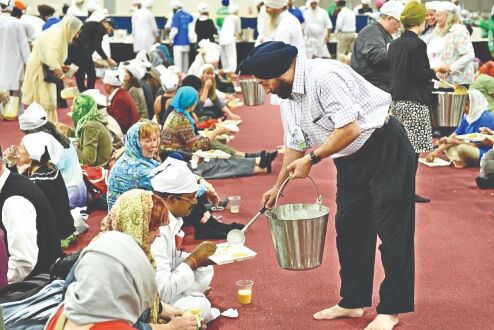Somehow, a Sardar can
It is a celebration, yet disquieting, that most things of real, ground-level relevance are being done primarily by our Sikh brethren; in the country and worldwide. Be it relief work in India, Afghanistan or Syria, langars on Delhi’s borders and every single Gurudwara, it is the Sardars who rush in and come to the aid of one and all

I am not a Sikh. I wish I was, though, for I would surely have been a truer and better person. The average Sikh is a simple, genuine and generous human being. I surely am not made of such mettle, as aren't many of you, and please don't mind the humbling revelation. Somehow, our everyday Sardar is humble and large-hearted, generation after generation, going back hundreds upon hundreds of years. I have a few Sikh friends, and their very approach to life is optimistic, and their very being is seemingly made of grit, guts, a smiling countenance and gold.
Be it relief work in India, Yemen, Afghanistan or Syria, langars on Delhi's borders or every single Gurudwara, it is Sardars who rush in and come to the rescue of one and all. Remember the terrible ordeal of the migrant laborers during the lockdown almost exactly a year back, who walked hundreds of kilometers to get back to their homes and villages? Well, not surprisingly, it was predominantly the Sikh community that came to their rescue, providing thousands and thousands with food, water and temporary shelter in those dark days. When natural calamities struck Kerala, it was again the Sikhs who emerged as the knights in shining armor, selflessly giving and serving.
Large-hearted Sikhs even took their traditional community kitchen to one of the world's most dangerous places in 2015; Syria. In the strife-hit Pesh Harbour area, about 35 kilometers from the Kurdish city of Duhok and 10 kilometers from the Syrian border, Sikh volunteers provided fresh bread and food items to nearly 15,000 refugees. And what's more, on the other side of the country, on the Lebanon-Syrian border, the Sikhs also helped refugees by running a school for 5,000 local children.
How did it all begin?
A langar is the community kitchen in a Gurudwara, which serves meals free of charge to all visitors, without making any distinction of religion, caste, gender, economic status or ethnicity. People sit and eat together, and the kitchen is maintained and serviced by Sikh community volunteers. The meals served at a langar are always vegetarian.
A quick Internet search throws up some interesting anecdotal information. And Sikh historian Gurinder Singh Mann says langar practices were already up and running in the 15th century among various religious groups, like Hindu Nath Yogis and Muslim Sufi saints. And Arvind-Pal Singh Mandair, a professor of Sikh studies, shares that community kitchens were already operating in Punjab when Guru Nanak founded Sikhism, and these were run by Gorakhnath orders and Muslim Sufi groups.
The concept of langar—designed to be upheld among all people, regardless of religion, caste, color, creed, age, gender, or social status—was an innovative charity and symbol of equality introduced into Sikhism by its founder, Guru
Nanak Dev ji around 1500 AD in Punjab. Guru Nanak Dev ji developed it as a part of the institutional framework that helped evolve the community free of any prejudices.
The roots of such community kitchen institutions and volunteer-run charitable feeding is very old in Indian tradition. For example, Hindu temples of the Gupta Empire era had attached kitchen and almshouse called dharma-shala or dharma-sattra to feed travelers and the poor for free, or whatever donation they may leave. These community kitchens and rest houses are evidenced in epigraphical evidence, and in some cases referred to as satram, choultry, or chathram in parts of India. In fact, Sikh historian Kapur Singh refers to langar as an Aryan institution.
Of khalifas and devotees
Chinese Buddhist pilgrim I Ching (7th century AD) wrote about monasteries with volunteer-run kitchens. A related concept emerged from the practices of Fariduddin Ganjshakar, a Sufi saint living in the Punjab region during the 13th century, who would redistribute the sweets brought by visitors to his khalifas and devotees. This concept developed, over time, into langar-khana near his shrine, a practice documented in Jawahir al-Faridi compiled in 1623 AD.
The second Guru of Sikhism, Guru Angad Dev ji, is remembered in Sikh tradition for systematizing the institution of the langar in all Sikh temple premises, where visitors from near and far could get a free simple meal in a simple and equal seating. Guru Angad Dev also set rules and training method for volunteers (sevadars) who operated the kitchen, placing emphasis on treating it as a place of rest and refuge, and always being polite and hospitable to all visitors.
It was the third Guru, Amar Das, who established the langar as a prominent institution and required people to dine together irrespective of their caste and class. He encouraged the practice of langar and made all those who visited him attend langar before they could speak to him.
Taking it a step further
Just last week, our friendly Sardars have taken things a giant step further—they have set up a Kidney Dialysis Hospital at Delhi's Gurdwara Bala Sahib. The Guru Harkrishan Institute of Medical Sciences and Research's new block at at the Gurdwara has been teeming with people since it opened its doors to anyone seeking free dialysis treatment. What's more, the 100-bed dialysis centre in Sarai Kale Khan is being touted as India's biggest such facility.
Asked about the lead-up to the setting up this facility, Delhi Sikh Gurudwara Prabandhak Committee president Manjinder Singh Sirsa revealed that a study conducted by them found that over 30 per cent of kidney patients don't have any access to medical facilities and are so poor that they have already sold off all their assets to pay for the treatment. "The concept of the hospital is we will not charge any money from patients. There are many who are coming out with contributions, there are people who feel that humans should be served, there are corporate houses who are coming forward. We will use these funds and won't charge from patients." The facility has received over 2,500 registrations within a few days of opening shop.
Such is the largesse of the community that one prominent Corporate body donated a 100 dialysis machines costing over Rs 10 crore to enable the center to begin providing treatment. And the plans are grandiose; Phase II of the dialysis center, which is barely a few months away, will see the hospital expand to 500 beds and machines, with each machine capable of performing around five dialysis treatments each day.
And crunch the numbers—with each dialysis treatment using up consumables of around Rs 2,000, the average daily running cost of the center will be around Rs 50 lakh. But such has been the response in terms of donations, from both Sikhs and non-Sikhs, that the DSGPC is confident of raising sufficient funds consistently to keep the noble venture going strong.
The three Sikh pillars
Clearly, the call to perform such acts of human kindness is ingrained into the very fundamentals of every Sikh, who is brought up with regular intonation of the three pillars of Sikhism, as outlined by Guru Nanak Dev ji—Naam Japo, Kirat Karo, Vand Chakko. Roughly translated, the three pillars ask that every Sikh person 'pray and chant the name of the Lord'; 'earn an honest living through hard work'; and 'share the earnings with others' and give back to the community.
With these three values, the Guru felt that every person would achieve spiritual elevation and material happiness in this world. Thus it is that Sikhs around the world continue to care and share life's gifts with others. Every Sikh donates at least 10 per cent of his / her earnings to Gurudwaras and charities, and that is what keeps their community services going, day after day, month after month and year after year—caring for and sharing with everyone who enters their doors.
No column on Sikhs today can be complete without a mention of what is happening on Delhi's borders, where the farmers' stir has now crossed a hundred days and shows no sign of withering anytime soon. If anything, the numbers are only increasing, with thousands and thousands from Uttar Pradesh, Haryana and other Indian states standing shoulder to shoulder with the Sikhs from Punjab who started it all on November 26, 2021.
And amongst the most poignant visuals from Delhi's borders is that of Sikh volunteers offering water and food to police personnel manning the barricades that prevent the farmers from entering India's Capital city. These same policemen, just a day before these visuals were captured, were dousing the farmers and volunteers with water from cannons, pelting and belting them with lathis and lobbing tear-gas shells to break up their agitation.
Clearly, the spirit of Naam Japo, Kirat Karo, Vand Chakko continues to shine loud and bright.
The writer is a communications consultant and clinical analyst. [email protected]
Views expressed are personal



